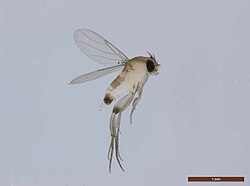| Megaselia | |
|---|---|
 | |
| Megaselia sp. | |
| Scientific classification | |
| Domain: | Eukaryota |
| Kingdom: | Animalia |
| Phylum: | Arthropoda |
| Class: | Insecta |
| Order: | Diptera |
| Family: | Phoridae |
| Subfamily: | Metopininae |
| Genus: | Megaselia Rondani, 1856 [1] |
| Type species | |
| Megaselia crassineura | |
| Synonyms | |
| |